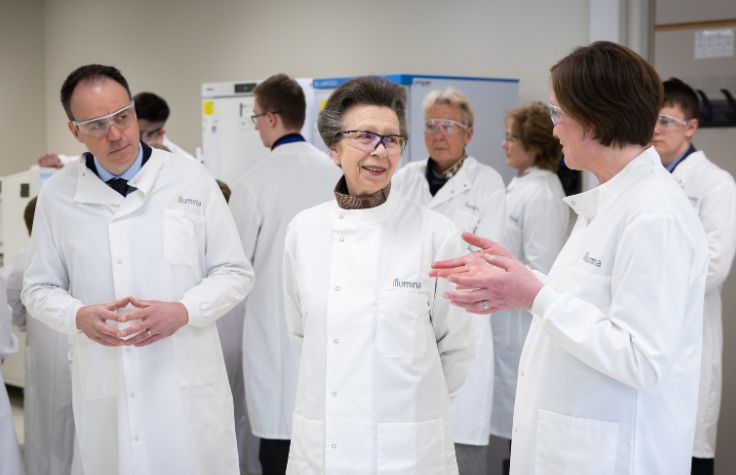
26 April 2024
On April 25, Illumina opened its doors in Granta Park, Cambridge, to celebrate DNA Day. This annual event marks a significant milestone in the history of science: the successful completion of the Human Genome Project in 2003 and the groundbreaking discovery of DNA’s double helix structure by James Watson and Francis Crick, along with Rosalind Franklin, in 1953.
This year’s DNA Day festivities at Illumina were joined by 150 enthusiastic children from schools in underserved areas of Cambridgeshire. The learners engaged in hands-on science activities, including extracting DNA from strawberries, and toured one of Illumina’s state-of-the-art laboratories. This behind-the-scenes glimpse into the world of genomic research was designed to inspire young scientists who may one day play pioneering roles in research and innovation at companies like Illumina.
During the event, the Illumina team was honored to welcome Anne, The Princess Royal, to Illumina’s Europe regional headquarters in Cambridge. The visit gave the students a unique opportunity to interact with King Charles’s sister as well as learn about the importance of genomics firsthand. The Princess Royal champions STEM education, encouraging kids to explore the world of science and increasing the presence of women in the field.
In keeping with the spirit of DNA Day, Illumina hosted their annual global genomic literacy initiative, The Future Is Bright, which exemplifies the company’s commitment to promoting equitable access to STEM education and inspiring the next generation of scientists. Throughout April, Illumina partners with schools and nonprofit organizations, such as Form the Future and Cambridge Science Centre, to provide educational programs and activities for learners of all ages.
Anne Bailey, CEO of Form the Future, says, “We are immensely grateful for Illumina’s support as our corporate partner, enabling us to engage primary school students in stimulating STEM activities. Their funding and dedication to releasing staff to work alongside us are instrumental in inspiring young minds and fostering a belief that a future in STEM is within reach, particularly for those from disadvantaged backgrounds. Together, we’re bridging the gap in our local economy, empowering a diverse array of students to pursue rewarding careers in the life sciences and beyond.”
In 2024, an expected 100,000 learners globally will participate in The Future Is Bright; in the UK alone, some 10,000 pupils benefited from the campaign and its spirit of collaboration and service. Watch the video below to see the highlights of the day.
Last year, The Future Is Bright hosted 130 events, reaching students in six countries and every US state. The program was powered by 1500 employee volunteer hours and 2300 donated strawberry DNA extraction kits. More than 1600 community partners and schools participated, and 71% of the American classrooms were part of Title 1 schools where low-income families make up at least 40% of enrollment. As of December 2023, Illumina has reached a total of 1.6 million STEM learners, as part of its target to reach 5 million by 2030. The Future Is Bright campaign is a key program in achieving this goal.
Through hands-on activities, engaging interactions, and valuable partnerships, Illumina continues its commitment to empowering young scientists and paving the way for a brighter future fueled by science and innovation.



